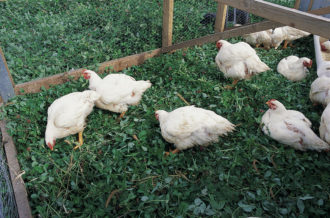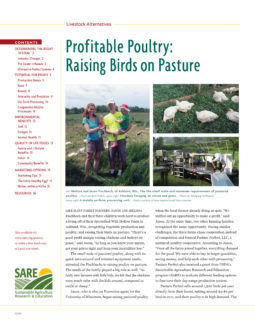Poultry can do a lot to remedy problem soil and control both insect pests and weeds while supplying a new revenue stream for the farm.
Soil
Birds on pasture or cropland act as miniature manure spreaders that fertilize the soil. They turn and mix soil and manure as they scratch for insects and worms, increasing organic matter and improving fertility. The calcium-rich manure from laying hens can raise the pH of soil over time, making the ground more conducive to highly palatable forages like clovers, vetches and orchardgrass. A word of caution: Birds can’t stay too long in one area or in high concentrations, especially when the ground is wet, as this kills forages and compacts the soil.
Steve Stevenson of Wisconsin’s CIAS worked with farmers who raise other livestock in addition to poultry on pasture. In each case, the chickens followed the larger animals, from dairy sheep to beef cattle. “We heard again and again that chickens do wonders for soil quality and nutrients,” he said. A flock of laying hens, run two to three days behind cattle herds, peck and scratch apart the cow patties as they eagerly gobble up the larva from the parasitic flies that prey upon the cows, accomplishing two tasks at once.
In Louisiana, SARE-funded researchers studying the benefits of integrating vegetables with broilers or layers found that vegetables grew best when planted 14 days after birds were moved across the plot. “We found significant improvement in plant performance 14 days after birds were on the land,” said James McNitt, a researcher at Southern University in Louisiana, who tested for the optimum time to plant cucumbers, summer squash, mustard greens and collard greens after pastured poultry.
Mark and Robin Way of Cecil County, Md., appreciate the extra nitrogen, phosphorous and other nutrients their flocks give to their hay fields. They move seven pens at a time across one of their four hay fields, and rotate to a new field each year.
“We’ve had soil tests, and we’re right where we should be,” Robin Way said. “The animals do well on the fields. They pick out bugs, and what they give back is extra nitrogen.”
Tom Delehanty’s birds help him overcome an obstacle endemic to New Mexico: poor soil. His birds are building a layer of rich organic matter atop the sandy desert ground to the point that he is considering expanding into organic produce.
“Between the rye and oats I plant both as cover crops and forage, and the scratching the birds do that works their manure down into the ground, I’m getting fertility like they’ve never seen around here,” he said. “I’ve got grain farmers coming from all over the valley to look at my pastures because they stay green all year long.”
Forages

Research, along with the observations of many producers, demonstrates that birds and pasture offer mutual benefits. Planting diverse forages that improve soil quality by fixing nitrogen or adding organic matter makes good sense, even though poultry producers sometimes debate how much grass or other forage meat birds and layers actually eat, and how much benefit they get from it. Unlike ruminants such as cows, goats and sheep, birds cannot digest the cellulose in most plants very efficiently, although turkeys and geese are better at it than chickens. That said, eating greens is the same for poultry as humans: A greens-only diet is not enough to sustain life, but greens do make a big difference in health.
Joel Salatin has established what he calls a “permanent polyculture” of clovers and grasses in his pastures, with varieties of native grasses, broadleaves, clovers, chicories, oats and rye that mature at different times of the season. His chickens will “eat almost anything as long as it’s not too tall and not too tough,” he said.
Oregon egg producer Robert Plamondon has found that pasture research from the early 1900s still applies. “Everything I’ve read points to oats as the ideal cool-season green feed,” he said, “while ladino clover, alfalfa and, to a lesser extent, other clovers are better summer feeds. My own experience with oats has been very favorable.”
Animal Health
Well-managed pastured flocks are generally resistant enough to disease and infections that many producers forego the use of antibiotics or medicated feed. Pastured-poultry producers often use this detail as a marketing tool. It is no secret that consumers want antibiotic-free chicken for their families. Significant problems with cannibalism are rare, so the practice of beak trimming is uncommon.
By contrast, chickens raised in confined houses are at risk for a host of respiratory illnesses because air quality is marred by ammonia and dust made up of excrement, litter, skin and feathers. To guard against illnesses such as bronchitis, coccidiosis and necrotic enteritis, confinement chickens receive routine inoculations and antibiotics, in addition to being fed additives such as arsenic.
Pastured birds, however, are more susceptible to weather-related stress. They can get too cold or too hot, exposed to rain and wind, and injured by predators. Chickens handle cold much better than heat, eating extra feed to produce heat through digestion as needed. Some steps to reduce heat stress during hot periods include ensuring adequate access to shade, refreshing water two to three times per day, and moving pens across pasture only in the morning or evening, when it is cooler.
Diseases such as coccidiosis can be a concern, especially in the brooder, if conditions are allowed to become unsanitary. To keep pathogens under control, use frequent rotations and allow pasture plots time to rest. Clean pens and brooders regularly between flocks to keep harmful microbes in check.
